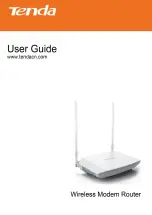
Modem Router Setup
23
N150 Wireless ADSL2+ Modem Router N150RM
Does Your Internet Connection Require a Login?
Answer either yes or no.
•
When no login is required, these fields display:
Account Name (If Required)
. Enter the account name that your ISP provided. This
might also be called the host name.
Domain Name (If Required)
. Enter the domain name that your ISP provided.
•
When your ISP requires a login, these fields display:
Encapsulation
. Encapsulation is a method for enclosing multiple protocols. PPP stands
for Point-to-Point Protocol. The choices are PPPoE (PPP over Ethernet) or PPPoA (PPP
over ATM).
Login
. The login name that your ISP provided. This is often an email address.
Password
. The password that you use to log in to your ISP.
Idle Timeout (In minutes)
. If you want to change the login time-out, enter a value in
minutes. This setting determines how long the modem router keeps the Internet
connection active after there is no Internet activity from the LAN. A value of 0 (zero)
means never log out.
Internet IP Address
.
When a login is required, these fields display:
Get Dynamically from ISP
. Your ISP uses DHCP to assign your IP address. Your ISP
automatically assigns these addresses.
Use Static IP Address
. Enter the IP address, IP subnet mask, and the gateway IP
address that your ISP assigned. The gateway is the ISP router to which your modem
router will connect.
Domain Name Server (DNS) Address
. The DNS server is used to look up site addresses
based on their names.
•
Get Automatically from ISP
. Your ISP uses DHCP to assign your DNS servers. Your ISP
automatically assigns this address.
•
Use These DNS Servers
. If you know that your ISP does not automatically transmit DNS
addresses to the modem router during login, select this option, and enter the IP address
of your ISP primary DNS server. If a secondary DNS server address is available, enter it
also.
NAT (Network Address Translation)
. You can enable or disable NAT. If you disable NAT,
you can also disable the firewall. The firewall cannot be disabled when NAT is enabled.
Secured NAT provides a secured firewall to protect the computers on the LAN from attacks
from the Internet, but might prevent some Internet games, point-to-point applications, or
multimedia applications from working. Open NAT provides a much less secured firewall, but
allows almost all Internet applications to work.
















































